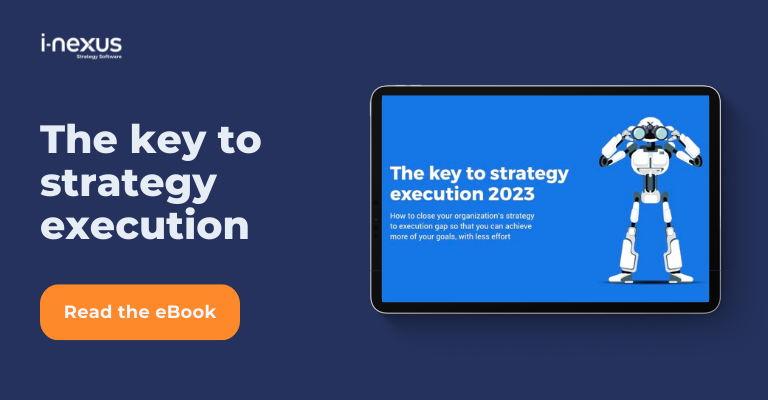There are countless challenges with strategy execution, but none are more critical than these seven. Here's why they matter and what you can do about them.
Success in strategy execution management doesn't come easily. The key is in the word "management." A lot needs to be done to orchestrate and guide your business through the hurdles and obstacles that come.
Some are big, some are small, some are common, and some are rare, but today we're looking at seven critical to success rates.
From resistance to change to breaking through the transparency barrier, if you can spot these challenges early, you can overcome them sooner while keeping your execution healthy.
If you've not had a chance to read the first two parts of the series, you can do so below:
- Strategies for effective Strategy Execution Management
- 5 best practices for Strategy Execution Management success
Challenge 1: Alignment and coordination
Challenge
Alignment and coordination are the cornerstones of successful strategy execution.
It refers to the organization's ability to ensure every department and team moves in sync with the strategic objectives.
When alignment is lacking, various parts of the organization operate in isolation, resulting in inefficiency, wasted resources, and, ultimately, the failure to meet strategic goals.
Why it matters
Inefficient alignment can lead to conflicting priorities, miscommunication, and resource wastage, ultimately derailing strategy execution.
When departments don't work cohesively towards a common goal, achieving the strategic vision becomes formidable.
Tools and techniques
Organizations can use tools like the Hoshin Kanri x-matrix, which visually aligns objectives and resources, providing a clear roadmap for execution.
Additionally, regular progress assessments and realignments are essential to maintain ongoing alignment.
Storytime: Bridging the alignment gap at TechPro Inc
TechPro Inc., a thriving (fictional) technology company, faced the significant challenge of alignment and coordination among its various departments.
This lack of alignment resulted in communication gaps and resource conflicts, as each department had its priorities, causing inefficiency and missed strategic objectives.
To overcome this challenge, TechPro Inc. implemented strategies that included utilizing the Hoshin Kanri X-Matrix, which visually aligned objectives and resources, and conducting regular progress assessments to maintain ongoing alignment.
The impact of these changes was remarkable. TechPro Inc. transformed from a siloed and inefficient organization into one with streamlined processes and cohesive collaboration. Their strategy execution became more effective, ensuring that departments and teams worked together towards common goals, ultimately achieving their strategic vision.
Challenge 2: Resisting change in strategy execution
Challenge
Resistance to change is a common challenge during strategy execution.
Employees and teams may avoid adopting new strategies, especially if they require significant changes to their established routines. Such resistance can hinder the implementation of a strategic plan.
Why it matters
Change resistance can lead to project delays, decreased morale, and reluctance to embrace new processes. With overcoming resistance, the organization may stay in the status quo, preventing the successful execution of the strategy.
Tools and techniques
Change management methodologies are instrumental in addressing this challenge. Creating a clear change management plan that includes communication, training, and support can help employees transition smoothly.
Storytime: Embracing change at NexaTech Solutions
NexaTech Solutions, a fictitious software development company, encountered a substantial challenge with employee resistance to change. This resistance to adopting new strategies and processes posed a significant hurdle to effective strategy execution.
To address this challenge, NexaTech Solutions devised a robust change management plan. This plan included clear communication, comprehensive training, and dedicated support for employees to transition smoothly into the new strategy.
The impact of these strategies was profound. NexaTech Solutions successfully managed employee resistance, facilitating the implementation of the new strategy. As a result, the company witnessed improved morale, streamlined processes, and a boost in overall strategy execution effectiveness.
Challenge 3: Battling inadequate resource allocation
Challenge
Inadequate resource allocation can severely hamper strategy execution.
When an organization fails to allocate the necessary resources, such as funding, personnel, or technology, to support the strategy, it can lead to delays, project stalls, and inefficiency.
Why it matters
Resource constraints can prevent the organization from effectively implementing its strategic objectives.
Strategic initiatives may become underfunded or understaffed without adequate resources, compromising success.
Tools and techniques
Robust resource allocation techniques include budgeting and staffing.
By optimizing resource allocation strategies and ensuring that resources align with strategic goals, organizations can enhance their strategy execution.
Storytime: Optimizing resource allocation at GenoMed Health
GenoMed Health, a fictional healthcare provider, faced the daunting challenge of inadequate resource allocation primarily due to budget constraints. This challenge hindered the effective execution of their strategic objectives, resulting in project delays, understaffed initiatives, and inefficiencies.
To overcome this challenge, GenoMed Health implemented comprehensive resource allocation optimization strategies. This involved meticulous budgeting and staffing efforts to align resources with their strategic goals.
The impact of these resource allocation improvements was substantial. GenoMed Health experienced a remarkable transformation in its strategy execution. They achieved project milestones on time, improved the efficiency of their operations, and successfully executed their strategic initiatives, all of which contributed to enhanced patient care and operational excellence.
To see how you can help your business with alignment, resources, and change, download our eBook:
Challenge 4: Overcoming unclear accountability and responsibilities
Challenge
In strategy execution, clear accountabilities and responsibilities can lead to clarity and project stalls. When roles and responsibilities are not defined, employees may not understand their tasks and contributions to the strategy's success.
Why it matters
Ambiguity regarding responsibilities can result in project delays, inefficiency, and a lack of ownership, hindering strategy execution. Clear accountabilities are vital for a smooth execution process.
Tools and techniques
Tools like the RACI matrix (Responsible, Accountable, Consulted, Informed) can define roles and responsibilities clearly. When individuals understand what is expected of them, execution becomes smoother.
Storytime: The accountability quest at VisionGate Inc.
VisionGate Inc., an imaginary biotech company, grappled with a significant challenge related to unclear accountabilities and responsibilities. This challenge resulted in confusion among employees regarding their roles and responsibilities in executing the company's strategic objectives.
To address this challenge, VisionGate Inc. implemented strategies to define and communicate clear roles and responsibilities within the organization. They utilized tools like the RACI matrix (Responsible, Accountable, Consulted, Informed) to outline the various roles and ensure everyone understood their responsibilities well.
The impact of these efforts was genuinely remarkable. VisionGate Inc. experienced a significant improvement in its strategy execution process. With well-defined accountabilities and responsibilities, projects moved forward more smoothly, resulting in increased efficiency and timely execution of their strategic initiatives. This transformation contributed to their growth and success in the highly competitive biotech industry.
Challenge 5: Breaking through the transparency barrier
Challenge
Transparency plays a pivotal role in strategy execution. An organization needs more transparency to ensure effective communication and decision-making. Teams may operate in silos, unaware of others' progress, leading to inefficiency and potential setbacks.
Why it matters
A lack of transparency can result in teams duplicating efforts, failing to meet deadlines, and an inability to adapt quickly to unforeseen circumstances. Transparent communication ensures that everyone is well-informed and engaged.
Tools and techniques
Transparent communication practices are essential, including regular progress sharing and open dialogue. Leveraging technology solutions that enable real-time visibility can also enhance transparency.
Storytime: Unlocking transparency at VisionMatrix Corporation
VisionMatrix Corporation, a fictional software company, faced a significant challenge related to a need for more transparency in its strategy execution. This lack of transparency led to inefficient communication, siloed teams, and a general lack of awareness about the progress of various initiatives within the organization.
To overcome this challenge, VisionMatrix Corporation implemented strategies to enhance transparency. They adopted transparent communication practices within the organization, such as regular progress sharing and open dialogue. Additionally, they leveraged technology solutions that provided real-time visibility into project progress and team performance.
The impact of these efforts was tremendous. VisionMatrix Corporation saw a substantial improvement in its strategy execution process. With enhanced transparency, teams operated cohesively, reduced duplicated efforts, and could quickly adapt to changing circumstances. As a result, the organization experienced increased efficiency and success in achieving its strategic goals. This transformation was pivotal in their growth and competitive advantage within the software industry.
Challenge 6: Establishing clear strategic priorities
Challenge
Prioritization is a critical challenge during strategy execution. When there are clear strategic priorities, employees may be confident about the importance of different tasks, leading to clarity, efficiency, and a lack of focus.
Why it matters
Confusion around priorities can result in wasted resources, misaligned efforts, and missed strategic objectives. Clear strategic priorities ensure employees know which tasks take precedence and where to focus their efforts.
Tools and techniques
Tools such as the Eisenhower Matrix, SWOT analysis, and the MoSCoW method can assist in prioritizing tasks effectively, enabling teams to align their efforts with strategic goals.
Storytime: Deciphering priorities at CoreTech Solutions
CoreTech Solutions, a fictitious IT consultancy, faced a significant challenge regarding unclear strategic priorities. Their employees often needed clarification about the importance of various tasks and struggled to understand where to focus their efforts within the organization.
CoreTech Solutions implemented strategies to communicate and establish clear priorities to address this challenge. They leveraged tools such as the Eisenhower Matrix, SWOT analysis, and the MoSCoW method to prioritize tasks effectively. These tools helped the teams align their efforts with the organization's strategic goals.
The impact of these efforts was substantial. CoreTech Solutions experienced improved efficiency and productivity with clear strategic priorities in place. Employees knew which tasks were of higher importance, reducing confusion and ensuring everyone was aligned with the company's strategic objectives. This transformation contributed significantly to their success and competitiveness in the IT consultancy industry.
Challenge 7: Cascading objectives to teams and individuals
Challenge
Cascading objectives to teams and individuals throughout the organization is a fundamental challenge.
Ensuring employees understand how their work contributes to the larger strategy is essential for successful execution.
Why it matters
When objectives are not communicated and aligned across the organization, employees may work in isolation, missing the opportunity to align their efforts with the strategic goals. Cascading objectives fosters a sense of purpose and unity.
Tools and techniques
Methods like the catchball process, which involves collaborative discussions and agreement on objectives at each level of the organization, can be used to ensure that objectives cascade effectively.
Storytime: The objective obstacle at PrimaTech Innovations
PrimaTech Innovations, a fictional manufacturing company, encountered a significant challenge in effectively cascading objectives to teams and individuals within their organization. This challenge often resulted in a need for more alignment and understanding of how individual contributions related to the company's overall strategic goals.
In response, PrimaTech Innovations implemented a collaborative approach inspired by the catchball process. This approach involved discussions and agreement on objectives at each level of the organization, ensuring that objectives were not dictated from the top but were cohesively defined and aligned throughout the company.
The impact of this strategic change was significant. PrimaTech Innovations experienced a newfound sense of purpose and unity among employees, enhancing collaboration and motivation. Employees at all levels understood how their work contributed to the larger strategy, leading to a more engaged and aligned workforce. This transformation significantly improved their strategy execution process and contributed to their growth and success in the manufacturing industry.
The takeaways
Addressing these critical challenges in strategy execution is vital for any organization aiming to achieve its strategic objectives effectively.
By understanding the significance of these challenges, implementing the right tools and techniques, and drawing inspiration from detailed fictional stories, organizations can gain valuable insights for navigating the complex landscape of strategy execution.
Overcoming these challenges proactively equips organizations to enhance their execution capabilities and achieve success in an ever-evolving business environment.
To see more about how you can help your business overcome these challenges, download our eBook:
Read more about strategy execution and related tools with our content below:
- Key to strategy execution eBook: Read how companies like Danaher and HP have mastered strategy execution and what you can learn from them.
- What role does a Strategy Realization Office play in your strategy execution?: Learn how you can govern your strategy execution with the emerging concept of the Strategy Realization Office (SRO)
- 13 ways to make your team care about goals: Try these 13 ideas for getting your team to buy into your goals, and create real accountability for delivering targets.
About the author
James Milsom is Head of Marketing at i-nexus. As Head of Marketing, his drive is to raise awareness and understanding of the challenges facing enterprises in delivering strategic objectives and transformation amidst changing markets and the obstacles traditional tools and methods present leaders.
If you’d like to talk strategy, contact James at james.milsom@i-nexus.com or connect with him on LinkedIn for the latest insights.



